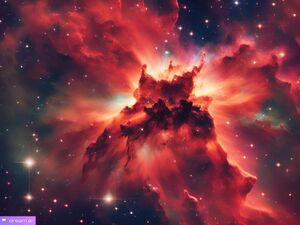
- Location
- 3.9 ly from the Epsilon Cuminiar Star System
- Sumutlis Sector
The Bone Nebula, a cryptic celestial formation teeming with heavy metal and crystalline gaseous compounds, orbits the Class M9V star Ossum. This region, filled with sensor-obscuring cosmic phenomena and asteroid fields, presents a mystery to the public who believe it abandoned. However, hidden in its depths is a clandestine network of stations. Amidst the dwarf planets within Ossum's clear zone, Occipital Station stands, showing signs of activity despite records of abandonment. Further concealed within this zone are Lunate Station and Talus Station, serving critical defense and operations roles unbeknownst to the public. Despite whispers of mysterious energy anomalies and vanishing ships, the Bone Nebula's secrets remain deeply guarded, known only to those privy to the enigmatic operations within its cosmic boundaries.
Public Perception
To the wider public, the Bone Nebula is perceived as an abandoned celestial wonder, devoid of any remarkable activity. Recent long-range sensor scans suggest otherwise, but the nebula's elusive nature obscures concrete evidence. Whispers of mysterious energy anomalies and vanishing ships around the nebula have stirred curiosity. Still, the nebula's secrets remain deeply shrouded, exposed only to those with direct knowledge of such scans. These suspicions, along with the potential activity in the vicinity, have yet to be officially acknowledged, painting the Bone Nebula as a tantalizing cosmic mystery that beckons the brave and the audacious.
The Star - Ossum
At the heart of the Bone Nebula lies the Class M9V star named Ossum, a radiant cosmic giant with a predilection for spewing strong gamma and x-ray emissions. These emissions refract off the nebula's dense gas cloud, creating a haunting visual spectacle of sensor ghosts and shadows that dance within the nebula's embrace. The unusually strong gravitational field of Ossum adds another layer of complexity to this dynamic stellar tableau, affecting the distribution of surrounding celestial bodies.
Anomalies
The nebula's star, Ossum, emits potent radiation flares which, combined with the highly reactive gas compounds in the nebula, create a cycle of turbulence and disruption within the nebula. These flares have a cascading effect, interacting with the nebula's gas compounds and triggering spontaneous, intense explosions. In turn, these explosions agitate the nebula's magnetic fields, causing sudden, severe disruptions that can disorient navigation systems and other crucial shipboard technologies. These phenomena combined with pockets of subspace turbulence scattered throughout the nebula, can further hamper FTL travel, destabilizing warp fields and potentially causing spatial disorientation. This intricate dance of cosmic forces transforms the Bone Nebula into a chaotic and treacherous landscape for any vessel attempting to navigate its depths.
The nebula's dense fields of fast-moving crystalline shards pose a particular risk to the integrity of a ship's hull. With the magnetic field disruptions within the nebula throwing off navigational systems, it can be alarmingly easy for a ship to inadvertently cross into these fields. The shards, sharp and quick, can breach the hull's protective layers. In such an event, the nebula's psychotropic gases could potentially infiltrate the compromised hull and enter the ship's air system. Once inside, the gases could induce powerful hallucinations among the crew, creating an internal crisis while the ship is still under the nebula's tumultuous grasp. The nebula's hazards, both external and potential internal, make traversing the Bone Nebula a perilous endeavor even for the most hardened of space-faring vessels.
- Highly Reactive Gas Compounds
- Certain pockets within the nebula contain highly reactive gas compounds that can trigger dangerous explosions when coming into contact with certain types of ship propulsion systems. These pockets are unpredictable and can cause catastrophic damage if a ship unknowingly enters one.
- Cosmic Radiation Flares
- Ossum, the star at the heart of the nebula, occasionally emits powerful radiation flares which can be hazardous to both lifeforms and electronic systems. Unprepared ships caught in one of these flares could suffer severe consequences, from system failures to life-threatening radiation exposure for the crew.
- Magnetic Field Disruptions
- The nebula experiences sudden, strong disruptions in the magnetic field. These disruptions can interfere with navigational systems, making it difficult for ships to maintain a steady course and possibly rendering compasses and other direction-finding equipment useless.
- Subspace Turbulence
- Pockets of subspace turbulence are scattered throughout the nebula, disrupting FTL travel. This makes the nebula a treacherous territory for warp-speed maneuvers. Ships attempting to engage FTL drives within these pockets can be thrown off course or even sustain damage.
- Sensor Ghosts
- The nebula's dense gas clouds and Ossum's radiation emissions create a myriad of sensor ghosts. This makes it incredibly difficult for ships to discern real threats from phantom readings, leading to potential navigation errors or overlooked dangers.
- Crystal Shard Fields
- Fields of sharp, fast-moving crystalline shards present a significant navigational hazard. These shards, carried on nebula currents, can puncture a ship's hull and damage systems if a ship inadvertently passes through such a field.
- Psychotropic Gases
- Some pockets of the nebula contain psychotropic gases, which can induce vivid hallucinations if a ship's atmospheric shielding is compromised. These hallucinations can severely impair a crew's ability to operate the ship and respond to actual threats.
Stations in the Nebula
A constellation of dwarf planets orbits Ossum within the clear zone of the nebula. These celestial bodies are barren, devoid of native life, but once hosted colony domes with strong shielding, built by a private company. Among these structures is Occipital Station, a once-thriving outpost built by the same pioneering corporation. Despite records indicating its abandonment, sensor logs from 2385 onward hint at possible activity within and around the station.
Hidden within this clear zone are two clandestine fortresses: Lunate Station and Talus Station. Their existence is not public knowledge, and yet they play a critical role in managing small craft combat operations outside the system and safeguarding the sector. Despite their crucial roles, these stations silently endure, cloaked in the nebula's mysteries.